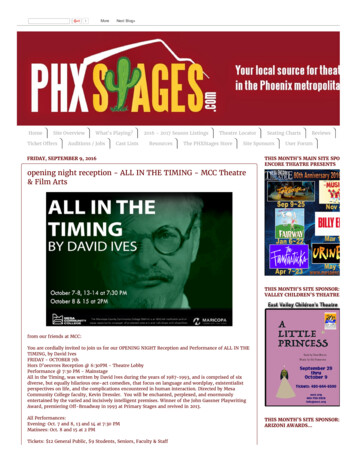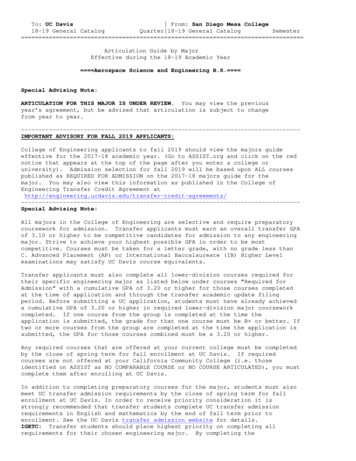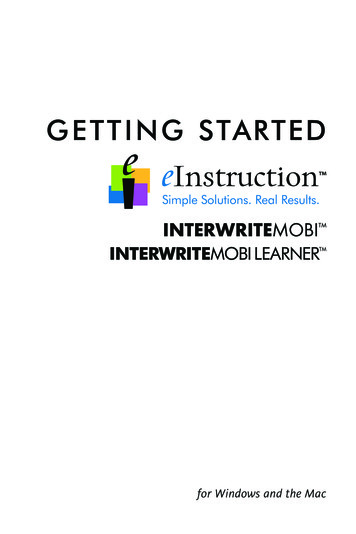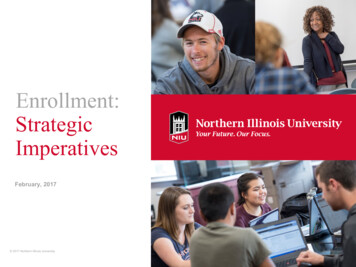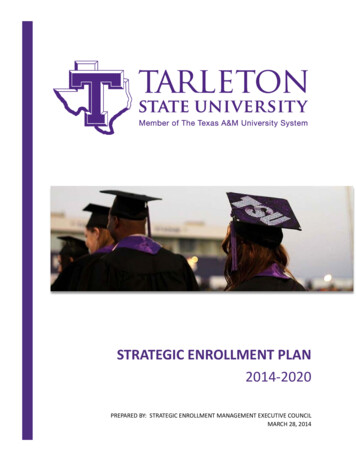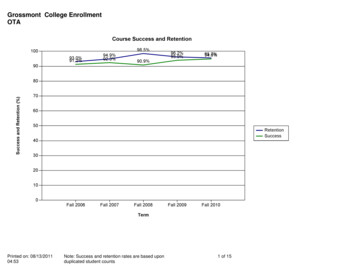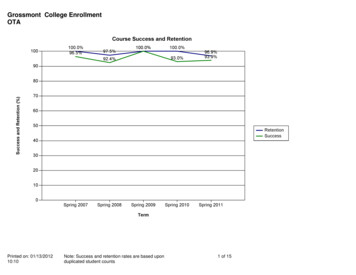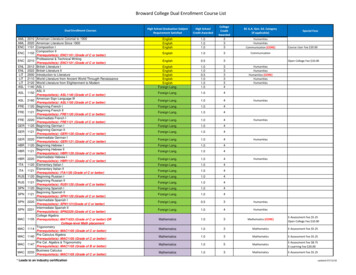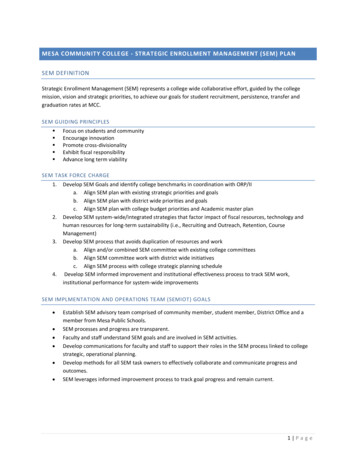
Transcription
MESA COMMUNITY COLLEGE - STRATEGIC ENROLLMENT MANAGEMENT (SEM) PLANSEM DEFINITIONStrategic Enrollment Management (SEM) represents a college wide collaborative effort, guided by the collegemission, vision and strategic priorities, to achieve our goals for student recruitment, persistence, transfer andgraduation rates at MCC.SEM GUIDING PRINCIPLES Focus on students and communityEncourage innovationPromote cross-divisionalityExhibit fiscal responsibilityAdvance long term viabilitySEM TASK FORCE CHARGE1.2.3.4.Develop SEM Goals and identify college benchmarks in coordination with ORP/IIa. Align SEM plan with existing strategic priorities and goalsb. Align SEM plan with district wide priorities and goalsc. Align SEM plan with college budget priorities and Academic master planDevelop SEM system-wide/integrated strategies that factor impact of fiscal resources, technology andhuman resources for long-term sustainability (i.e., Recruiting and Outreach, Retention, CourseManagement)Develop SEM process that avoids duplication of resources and worka. Align and/or combined SEM committee with existing college committeesb. Align SEM committee work with district wide initiativesc. Align SEM process with college strategic planning scheduleDevelop SEM informed improvement and institutional effectiveness process to track SEM work,institutional performance for system-wide improvementsSEM IMPLMENTATION AND OPERATIONS TEAM (SEMIOT) GOALS Establish SEM advisory team comprised of community member, student member, District Office and amember from Mesa Public Schools.SEM processes and progress are transparent.Faculty and staff understand SEM goals and are involved in SEM activities.Develop communications for faculty and staff to support their roles in the SEM process linked to collegestrategic, operational planning.Develop methods for all SEM task owners to effectively collaborate and communicate progress andoutcomes.SEM leverages informed improvement process to track goal progress and remain current.1 P a g e
SEM PLAN STRUCTUREThe SEM Plan contains four broad Goals:1.2.3.4.The SEM Plan will support the Academic Master Plan (AMP).Outreach, recruitment and marketing efforts support college enrollment and FTSE goals.Meet or exceed college enrollment and FTSE goals by increasing student success, retention, persistenceand completion.Increase student satisfaction and engagement across all support services and academic affairs to meet orexceed comparable national cohort scores.Each SEM Goal is supported by high-level objectives and strategies, and bracketed information after Objectives orStrategies indicates proposed task owners, like [SEM Task Force]. Finally, the end of each Goal section lists GoalAlignments and Connections with district and MCC plans and initiatives, SEM Focus Areas and College Impacts (HR,Fiscal and IT). Currently, all impacts for HR, Fiscal and IT are to be determined, as individual task owners will needto assess these impacts at the Strategy or Objective level.The five SEM focus areas, illustrated in the graphic below, represent key phases in the student life cycle(Recruitment and Outreach, Matriculation and Enrollment, Academic Progress, Goal Attainment and PostCompletion):Strategic Enrollment Management Visualization of SEM Focus AreasMatriculationand EnrollmentRecruitment cial AidPlacement TestingAcademicProgressDevelopmental Ed.College-level EducationCourse ManagementeLearningRetentionPersistenceContinued AdvisingWorkforcePostCompletionGoal AttainmentAward norsCommunityInvolvementContinuing Ed.RetrainingCareer-ReentryStop Out and Drop Out Recovery / Retention/ Persistence ProgrammingMCC Vision, Mission, ValuesAcademic Master PlanFacilities / Learning Spaces / Technology / Human ResourcesStudent Life / Student Experience / Student Connections / Community EngagementSEM NEXT STEPSThis document will be vetted by individuals representing SEM Special Interests Advisory Team: K-12, District Officeand the community. Once vetted and altered accordingly, the SEM Taskforce will recommend individuals to formthe SEM Implementation and Operations Team (SEMIOT). The SEMIOT will identify more specific task owners forSEM Goals, Objectives and Strategies and work with task owners to develop implementation timelines and successmetrics. In addition, SEM will be linked to the department planning process as well as other crucial planning withinand throughout the college.2 P a g e
Goal 1: SEM Plan will support the Academic Master Plan (AMP) .Objective 1.1: Ensure SEM Goals, Objectives and Strategies support, align and integrate with AMP.Strategy 1.1: Create a SEM Implementations and Operations Team (SEMIOT). [SEM Task Force]Strategy 1.2: Once AMP is complete, create an AMP-SEM working team to integrate and align SEMplan with AMP. [SEMIOT; AMP committee]Goal 1 Alignments and ConnectionsDistrict Core Planning Areas: Access to Learning, Pathways to Student Success, Effective Learning and Teaching,Organizational IntegrityOther District Initiatives: NAMCC Strategic Priorities: Student Success, E-Learning, Workforce DevelopmentAMP Learning Priorities: TBDMCC SEM Focus Area: AllCollege ImpactsHR Impact: TBD by task ownersFiscal Impact: TBD by task ownersIT Impact: TBD by task owners3 P a g e
Goal 2: Outreach, recruitment and marketing efforts support college enrollment and FTSEgoals 1.2Objective 2.1a: Yield 30% conversion rate from admissions to enrollment among key market segments .[Outreach and Enrollment Development]Objective 2.1b: Market penetration meets or exceeds NCCCBP median. [Outreach and Enrollment Development;Institutional Advancement]Objective 2.1c: Recruitment, outreach and marketing efforts support college enrollment and FTSE goals.[Outreach and Enrollment Development; VPSA; Institutional Advancement]Strategy 2.1.1: Align efforts with comprehensive, integrated and measurable marketing, recruitmentand outreach plan, as well as district IMOR2 and One Maricopa initiatives.Strategy 2.1.2: Assess and identify market segments (both local and online) yielding high rate ofreturn (e.g. number enrolled).Strategy 2.1.3: Identify and pursue market segments that yield students with high levels ofenrollment intensity (i.e. populations more likely to attend college full-time).Strategy 2.1.4: Optimize use of technology and electronic resources in recruitment, outreach andmarketing activities.Strategy 2.1.5: Leverage college programs and services with economic and workforce trends andcommunity engagement.Strategy 2.1.6: The MCC brand will remain competitive in the face of increased market competition.Strategy 2.1.7: Recruitment, outreach and marketing support a diverse student body and expandaccess.Objective 2.2: Achieve goals for Mesa Counts on College (MCOC) initiative. [Outreach and EnrollmentDevelopment; VPSA]Strategy 2.2.1: Incorporate objectives and goals from MCOC with SEM plan.Strategy 2.2.2: Continue partnerships and initiatives established by MCOC now that the grant hasterminated.Strategy 2.2.3: Strengthen partnerships with and outreach to middle and high schools.Goal 2 Alignments and ConnectionsDistrict Core Planning Areas: Access to Learning, Pathways to Student SuccessOther District Initiatives: IMOR2, One MaricopaMCC Strategic Priorities: Student Success, E-Learning, Workforce DevelopmentAMP Learning Priorities: TBDMCC SEM Focus Area: Outreach/Recruitment, Matriculation and Enrollment, Post CompletionCollege ImpactsHR Impact: TBD by task ownersFiscal Impact: TBD by task ownersIT Impact: TBD by task owners12College enrollment and FTSE goals to be determined and monitored by college leadership.30% Yield Objective set by Dean Community Outreach and Development4 P a g e
Goal 3: Meet or exceed college enrollment and FTSE goals 3 by increasing student success,retention, persistence and completion.Objective 3.1: Increase retention, persistence and subsequent college-level success rates among developmentaleducation students; rates will meet or exceed NCCBP median.Strategy 3.1.1: Use informed improvement process to assess indicators of developmental studentsuccess and failure and develop a plan to increase developmental student success and persistence(including traditional developmental students as well as ESL students). [Dev. Ed. Committee; FSS;ENG/RDG/MAT Department Chairs; VPAA]Strategy 3.1.2: Provide and support professional development opportunities for faculty to explorebest practices regarding pedagogy and student retention and persistence. [Dev. Ed. Committee;ENG/RDG/MAT Department Chairs; VPAA]Strategy 3.1.3: Ensure placement testing accuracy. [Testing Services; Dev. Ed. Committee;ENG/RDG/MAT Department Chairs; VPAA]Strategy 3.1.4: Identify and implement new methods to increase the speed students are able tocomplete their developmental education sequences. [Dev. Ed. Committee; FSS; ENG/RDG/MATDepartment Chairs; VPAA]Strategy 3.1.5: Expand student-to-student and employee-to-student mentoring programs and earlyalert programs. [Connect 4 Success; FSS; Dean Student Retention]Objective 3.2: Increase course success and retention rates to meet or exceed NCCBP median.Strategy 3.2.1: Provide and support professional development opportunities for faculty to explorebest practices regarding pedagogy and students retention and persistence. [Department Chairs; CTL;Deans of Instruction; VPAA]Strategy 3.2.2: Develop a plan to increase eLearning course success and retention rates to meet orexceed the rates of face-to-face courses. [Dean Innovative Learning; eLearning Committee]Strategy 3.2.3: Increase student awareness and track use of Academic Support Services (e.g. LearningEnhancement Center, Academic Skills Center, Writing Lab, and so on) to increase student success andretention. [Department Chairs; Deans of Instruction; VPAA; Dean Student Retention]Strategy 3.2.4: Using informed improvement process, identify interventions to increase retention andpersistence of diverse student groups to increase overall course success. [Department Chairs; Deansof Instruction; VPAA; Dean Student Retention; ORP]Objective 3.3: Increase student enrollment intensity (i.e. students enrolling in more credit hours), as measuredby average credit hours attempted and increases in higher academic loads (e.g. full-time, three-quarter time,half-time).Strategy 3.3.1: Develop and implement robust enrollment counseling process and programming topromote and support increased enrollment intensity, including items such as financial aid literacy,early and continued academic advising (establish individual learning plans early in student career andcontinuous recommendations for course sequences), career exploration, and so on. [Advising;Financial Aid; Dean Enrollment Services; VPSA]3College enrollment and FTSE goals to be determined and monitored by college leadership.5 P a g e
Strategy 3.3.2: Provide a college-wide advisement model that aligns across divisions, complimentsacademic instruction and student retention, success and completion. [Advisement; DepartmentChairs; Dean Enrollment Services; VPSA; VPAA]Strategy 3.3.3: Increase support for online learners. [Dean Innovative Learning; eLearning Committee]Strategy 3.3.4: Ensure adequate cross-training and professional development of all student servicesstaff. [Deans of Student Affairs; VPSA]Strategy 3.3.5 (links to Strategy 3.6.1): Develop a comprehensive recovery program for students whostop-out, drop-out or otherwise fall out of contact before completing (i.e. completed SIF but didn’tenroll or took placement tests but didn’t enroll). [Deans of Student Affairs; VPSA]Objective 3.4: Implement a comprehensive course management system/office that balances efficient andeffective use of college resources and student needs. [Department Chairs; Deans of Instruction; VPAA; VPAS]Strategy 3.4.1: Course enrollment levels and schedule of classes meets student needs and supportscollege enrollment and FTSE goals.Strategy 3.4.2: Leverage Maricopa Priorities to identify and assess programs with low FTSE and highcosts.Strategy 3.4.3: Using historical trends and predicted future demands, departments establish apredictable cycle of course offerings to allow for longer-range academic advising and development ofaccurate student learning plans.Objective 3.5: Current and relevant technologies are available to use both in the classroom and in all areas ofstudent support to improve services related to retention and persistence efforts. [Department Chairs; VPAA;Technology Steering Committee; VPIT; SEMIOT]Strategy 3.5.1: The Technology Steering Committee, directed by the VPIT will complete campustechnology audits, surveys and environmental scans to ensure campus strategically uses technologyto benefit student retention, persistence and completion.Strategy 3.5.2: Align SEM objectives and strategies with the IT Strategic Plan.Objective 3.6a: Increase the number of graduates and awards by 50% (2010 baseline) by year 2020 (aligned with4MCCCD goals based on President Obama’s initiative) .Objective 3.6b: Meet or exceed NCCBP median for completion and transfer rates.Strategy 3.6.1 (links to Strategy 3.3.5): Develop a comprehensive recovery program for students whostop-out, drop-out or otherwise fall out of contact before completing (i.e. completed SIF but didn’tenroll or took placement tests but didn’t enroll). [Deans of Student Affairs; VPSA]Strategy 3.6.2: Match students with engaging programs and career paths by developing individualizedlearning plans as early in a student’s career as possible. [Advising; Deans of Student Affairs; VPSA]Strategy 3.6.3: Increase participation in university partnership programs. [Advising; Deans of StudentAffairs; VPSA; VPAA]Strategy 3.6.4 (links to Objective 3.3): Increase student enrollment intensity to decrease time tocompletion or transfer. [See Strategies under Objective 3.3 for task owners]Strategy 3.6.5: Develop and maintain a comprehensive SEM Predictive Model. [ORP]4See Appendix D for current Objective 3.6a progress.6 P a g e
Objective 3.7: Measure and develop goals for non-standard completions for non-traditional students (e.g. nonaward seeking, personal interest, only here for a class, etc). [ORP; Workforce]Strategy 3.7.1: Define and measure successful completion for students indicating intents other thanseeking a degree, certificate or transfer.Strategy 3.7.2: Identify other indicators of successful completion, such as licensure rates, exampassage rates, job placement rates and attempted vs. earned credit hours.Goal 3 Alignments and ConnectionsDistrict Core Planning Areas: Access to Learning, Pathways to Student Success, Effective Learning and TeachingOther District Initiatives: One Maricopa, SSE, IMOR2, Maricopa Priorities, Completion Agenda, DevelopmentalEducation InitiativeMCC Strategic Priorities: Student Success, E-Learning, Workforce Development, RetentionAMP Learning Priorities: TBDMCC SEM Focus Area: Matriculation and Enrollment, Academic Progress, Goal Attainment, Post-CompletionCollege ImpactsHR Impact: TBD by task ownersFiscal Impact: TBD by task ownersIT Impact: TBD by task owners7 P a g e
Goal 4: Increase student satisfaction and engagement across all support services andacademic affairs to meet or exceed comparable national cohort scores.Objective 4.1: Satisfaction and engagement scores on national surveys administered at MCC will meet or exceedcomparable national cohorts.Strategy 4.1.1: Establish customer service expectations utilizing best practices and create a studentfirst culture. [Deans Students Affairs; VPSA]Strategy 4.1.2: Encourage professional development opportunities for staff, faculty andadministrators. [HR; All functional units]Strategy 4.1.3: Continue college-wide use of informed improvement process to leverage survey datafor positive interventions. [All departments]Strategy 4.1.4: Create a culture of volunteerism and community involvement. [Service Learning,VPSA; VPAA; President’s Office]Strategy 4.1.5 (links to Strategy 3.1.5): Increase student-student and employee-student engagement.Objective 4.2: MCC will have robust student programming options that are both co-curricular and engaging, asmeasured by increasing satisfaction and engagement scores in the Community College Survey of StudentEngagement and the Noel-Levitz Student Satisfaction Inventory.Strategy 4.2.1: Partnerships between retention/support services and academic departments to createco-curricular programs for students that speak to their areas of study. [Dean Student Retention;VPSA; Department Chairs; VPAA]Strategy 4.2.2: Partnerships within student affairs departments to support more comprehensive,holistic student programs. [Students Affairs Departments; Deans Student Affairs; VPSA]Goal 4 Alignments and ConnectionsDistrict Core Planning Areas: Access to Learning, Pathways to Student Success, Effective Learning and Teaching,Organizational IntegrityOther District Initiatives: SSEMCC Strategic Priorities: Student Success, E-LearningAMP Learning Priorities: TBDMCC SEM Focus Area: Matriculation and Enrollment, Academic Progress, Goal Attainment, Post-CompletionCollege ImpactsHR Impact: TBD by task ownersFiscal Impact: TBD by task ownersIT Impact: TBD by task owners8 P a g e
Appendix A: Glossary of TermsAcademic Master Plan (AMP) – Administration andfaculty at MCC are currently working on this AMPand is due to be completed by the end of the 20132014 school year.Access to Learning – One of four MCCCD CorePlanning Areas, defined as: MCCCD provides accessto learning opportunities for students and thecommunity.Community College Survey of Student Engagement(CCSSE) – One of four national surveys administeredat MCC, measuring student satisfaction andengagement.Completion Agenda - MCCCD is committed toincrease the number of students completingassociate degrees, certificates, and/or successfultransfer to one of Arizona’s public or privateuniversities by 50 percent by the year 2020.Developmental Education Initiative - By leveragingstrategies and innovations developed at the colleges,MCCCD will improve developmental educationoutcomes, close achievement gaps, and addressstudent access to college-level courses and programsof study.Effective Learning and Teaching - One of fourMCCCD Core Planning Areas, defined as: MCCCDresearches, assesses, and improves student learningand invests in strategies to improve organizationallearning and effectiveness.eLearning - MCC eLearning provides courses that useinternet technology to enable innovation and qualityeducational experiences. MCC eLearning representsthe college's dedication to enriching and expandingaccess to higher education.ESL – English as a Second LanguageFull-time student – For fall and spring semesters, astudent enrolled in 12 or more credit hours.Full Time Student Equivalent (FTSE) – State fundingis based on this calculation. Basic Fall and SpringFTSE is total credit hours divided by 15. For fiscalyear FTSE totals, Fall and Spring are averaged andFTSE for non-basic classes (e.g. short-term and openentry) are added.Headcount – The unduplicated number of studentsenrolled for credit at any given time.IMOR2 – The Integrated Marketing, Outreach,Recruitment, and Retention initiative (IMOR2) isresponsible for developing an inclusive approach topromoting enrollment and retention through acommon communication platform and otherstrategies. The initiative provides a vision and set ofrecommendations to guide communication,recruitment, and retention efforts.Informed Improvement - MCC’s Quality Initiative foraccreditation that empowers a culture of evidencebased decision-making dedicated to advancingstudent success.Maricopa Priorities – Starting in FY 2013-14, theMaricopa Community Colleges will begin a processof self-assessment, assessment, and prioritization ofall programs and services. This process known asMaricopa Priorities will aid us in collectivelyrealigning res
MESA COMMUNITY COLLEGE - STRATEGIC ENROLLMENT MANAGEMENT (SEM) PLAN SEM DEFINITION Strategic Enrollment Management (SEM) represents a college wide collaborative effort, guided by the college mission, vision and strategic priorities, to achieve our goals for student recrui
